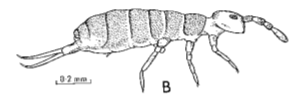![]() Over the last 18 months the calls have been ever increasing. “There are these things … well, they are very small, minute … they jump .. don’t sting .. never seen them before. What are they?”
Over the last 18 months the calls have been ever increasing. “There are these things … well, they are very small, minute … they jump .. don’t sting .. never seen them before. What are they?”
 In fact, two customers of pest managers were about to move out because of the home invasion by these minute creatures. “I clean them up and they are back straight away.” So many, so annoying.
In fact, two customers of pest managers were about to move out because of the home invasion by these minute creatures. “I clean them up and they are back straight away.” So many, so annoying.
One school headmaster was worried about masses of small jumping things on their concrete path in a circle about 150mm diameter. (These animals are moisture sensitive and were concentrated in the low lying, and last-to-dry, hollows of the concrete.)
BACKGROUND
Before insects there were other hexapods (six legs). Superclass HEXAPODA consists of four classes – Collembola, Protura, Diplura and Insecta. The mouthparts of the first three classes are enclosed within the head capsule separating them from insects where the mouthparts are external.
So what are these primitive pre-insects? Collembola are widespread Protura are less than 2mm long and uncommon, sometimes they are found when sampling moist soil. Diplura range up to 50mm but are mainly found under logs and stones and in moist soil.
COLLEMBOLA (SPRINGTAILS)
Collembola are small – most less than 6mm. Over 2,000 species have been described from subarctic regions through the tropical areas and on to Antarctica. In Australia they have been found in intertidal zones on coral reefs through to Mt Wellington in Tasmania where large dark patches on the snow were actually many thousands of springtails.
They respire through their porous skin. This makes them prone to desiccation so they are often found in damp areas.
Fossil records date springtails to at least 400 million years ago. By sheer numbers they are one of the most abundant of all animals with up to 100,000 individuals per cubic metre of soil. They are most frequently found in leaf litter and other decaying material but they are also one of the most abundant groups in trees, especially in tropical areas. They are one of the main biological control agents of soil microorganisms.
Their common name ‘springtail’ comes from their ability to ‘jump’ when disturbed. Most species have a ‘tail’ called a furcula that is folded under the body and held under tension by a small clip on the abdomen. When the furcula is released, it snaps against the ground, flinging the springtail into the air. All this takes place in about 18 milliseconds. The photo shows a springtail soon after release of the furcula.
BENEFITS
Most springtails play an active role in cleaning up the micro-environment by feeding on decaying vegetable matter, algae, fungi and lichens, decomposing animal matter such as earthworms and flies. Springtails play a positive role in the transmission of some symbiotic fungi in agriculture. They also consume some disease causing micro-organisms.
PEST STATUS
One group of collembola prefer to eat fresh plant material – the 'lucerne flea' causes severe damage to agricultural crops in the winter rainfall areas of southern Australia. There is evidence that scales or hairs from springtails can cause irritation when rubbed into the skin. They can sometimes build up to very large populations in damp rooms such as bathrooms and basements.
MANAGEMENT
There are 60 products registered for control of the lucerne flea – all are based on organophosphate or carbamate actives. None of those actives are registered for use inside houses. Household aerosols appear to kill the springtails but if they keep coming it is important to find the source.
Collembola prefer moist conditions. Most problems are reported after periods of poor rainfall. They can climb smooth surfaces in their quest to find moisture. Many of the problems reported appear to be one-offs as the normal habitat dries and the springtails move to find a moist area. The adults produce a pheromonel, so where some survive, others will join them.
If the problem persists check for moist areas where they may be breeding. This may range from outside in the moist soil to under the bath. If outside, treat the perimeter of the building, including up the walls. If inside, check for leaks in plumbing or other reasons that make the area conducive to their survival.
